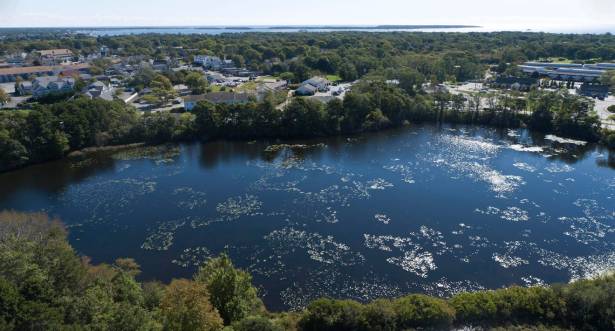PFAS Contamination: Of 21 Barnstable Ponds Tested, 21 Had Contaminants, Town Report Finds
By Jeanette Hinkle | Cape Cod Times | October 4, 2021

Read the full article by Jeanette Hinkle (Cape Cod Times)
“In July 2020, Tom Cambareri dragged his kayak to the shore of Aunt Bettys Pond in Barnstable. He paddled out to the middle and dropped his sampling equipment into the water.
Cambareri, a hydrologist and the founder of Sole Source Consulting, was on a mission for the town of Barnstable. His goal was to better map the landscape of PFAS contamination in the town’s surface water bodies as the search for new sources of drinking water to meet rising demand intensifies.
Cambareri ultimately collected water samples from 21 water bodies in town, according to a report he produced in December 2020.
The results from lab tests of those samples showed PFAS compounds were present in every water body tested, with some registering PFAS levels far above the state standard for drinking water. There is no standard for PFAS contamination insurface water bodies, such as ponds and creeks.
PFAS, or per- and polyfluoroalkyl substances, are a group of thousands of manmade chemicals linked to health problems ranging from immune system issues to cancer. The chemicals remain essentially unregulated at the federal level, but some states, including Massachusetts, have begun to put safe drinking water limits on a few of the more well-researched compounds.
In 2020, Massachusetts instituted a drinking water standard of 20 nanograms per liter for a group of six PFAS compounds, which are now known as the PFAS6.
Of the 21 samples Cambareri collected, seven had PFAS6 levels that exceeded the state drinking water standard. The sample taken at Aunt Bettys Pond had one of the highest readings: 141.4 nanograms per liter, roughly seven times the state drinking water standard.
Cambareri tested for 18 other PFAS compounds that haven’t yet been regulated by the state or federal government.
Three water bodies had total PFAS levels exceeding 200 nanograms per liter, three had levels exceeding 100 nanograms per liter, and five had levels exceeding 20 nanograms per liter.
At Aunt Bettys Pond, total PFAS levels registered at 237.9 nanograms per liter, the second-highest reading after its feeder system, Hyannis Creek, where levels topped 252 nanograms per liter.
When Cambareri compared PFAS levels in the surface water bodies he sampled to PFAS levels in Hyannis’s public drinking wells before treatment, he confirmed that contamination in ponds, lakes and creeks was correlated with contamination in village wells.
‘… Areas with high concentrations of PFAS contamination in surface water bodies also have similarly high concentrations of contamination in wells,’ Cambareri wrote.
‘Because of this relationship we can assume that development of wells in an area with high concentrations of PFAS in surface water would result in high concentrations of PFAS in wells, thus resulting in higher treatment costs,’ he added.
Laurel Schaider, a senior scientist at Silent Spring Institute, where she leads the institute’s water quality research on PFAS, reviewed Cambareri’s report at the Times’ request.
‘I think this is a really important report,’ Schaider said Friday. ‘It’s a reminder of the interconnectedness of groundwater and surface water on the Cape. Given what we know about the high levels of PFAS reaching the drinking water wells in Hyannis, it’s not surprising that the ponds in those same areas have similar levels of PFAS.’
Cambareri said in his reportthat, as the town considers new sources of drinking water, it should rule out places where PFAS contamination is known to be present in nearby surface water bodies.”….
This content provided by the PFAS Project.
Location:
Topics: